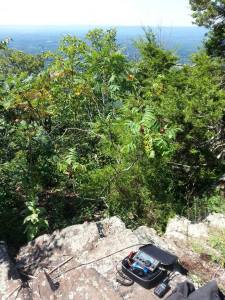In the search for the “Wonder Antenna” that is small, portable and easy to setup, I’ve decided to build an Endfed antenna using a 9:1 match. This antenna has been made popular by the Emergency Amateur Radio Club of Hawaii (EARCHI). It consists of 30ft of wire fed into a 9:1 UnUn (Unbalanced to Unbalanced).
Plans for the Antenna are available from EARCHI’s website
I’ve been wanting to make the antenna for quite a while but I’m lazy when it comes to ordering things online. During the spring of 2013 I went to a regional hamfest located in New Hampshire hoping to find the T106-2 toroid that was called out for in the plans. I saw a bunch of red toroids and decided to purchase them hoping it was the correct mix and size.
I ended up with what appears to be a T130-2 toroid. It’s a little bit bigger than the T1o6 but uses the same mix.
The Build
It wasn’t that bad… If you follow the instructions the build only takes about 15 minutes or so. I mounted everything inside of a plastic tooling container. Instead of using a chassis mount SO-239 I went with a small length of RG-58 coax with a BNC at one end. The reason I did that was because there is always a strong chance that I’ll forget the coax and could at least use the pig tail connected to the radio.
The plan is to get this into even a smaller container.
Let’s hook it up to the Analyzer.
Before attaching it to my radio, I wanted to hook it up to the analyzer just to make sure I have the correct toroid being used. When it comes to buying toroids at hamfests, you could be taking a gamble unless it’s clearly marked. I might have purchased a different type even though it’s red in color.
What I’ve done is hooked up a bunch of resistors to the output and ground of the unit. The resistors should add up to 450ohms. Since it’s a 9:1 balun (or unun in the end use), 9 goes into 450 50 times which we should see 50ohms on the otherside if all is correct.
With the 450 ohm load. The analyzer is see approximately 50ohms across the HF bands allocated for Amateur Radio. However on 6M the SWR and impedance is quite high. However this is most ideal situation. That’s not going to happen when the wire is hooked up as it will not have a 450ohm resistance.
Here is a video I made testing the EARCHI with the MiniVNA PRO
What about the counterpoise or the other half of the antenna?
If you look at the design, you will see that the “ground” is hooked up to the shield of the coax, so it would be suggested that you run some length of coax between the match box and your radio.
Testing the antenna in the real world
One could sit there and talk all day about using the antenna. Let’s see what it can do
I tested this right outside on my deck using a 31 foot fiberglass pole. The wire is 30ft of #18 Poly-stealth.
The antenna only took around a minute or two to raise. I wasn’t really planning on making a video or even using the antenna that day so the batteries on the KX3 were not charged nor did I have it hooked up to an external source. I was using 3watts to conserve battery.
I went onto 15m and within minutes I managed to make a DX contact with LY10NATO which is a special event station in Lithuania. Not bad considering my conditions. The bands must have been in good shape. I then went to 20 and made contact with W1AW/4, an ARRL Centennial station in Tennessee.
I know it’s not proper to judge an antenna based solely on contacts but it just proves that it works. If you need a QRP antenna that is portable and can get you on the air quickly then I would suggest the EARCHI to anyone. It’s easy to build and if you don’t have the time you can purchase one from EARCHI. It’s not a “Wonder Antenna” by any means but it’s hard to beat consider the cost and ease of use. Also having a decent match (tuner) helps.
Edit (4/3/2014): Someone on Youtube asked about SWR reading with the EARCHI. I decided to hook up the antenna to the KX3 with the internal ATU option using a couple configurations and here are the results. Please keep in mind the ATU in the KX3 has a wide ratio and could match a lot of wire. Doesn’t make the antenna any more efficient but it makes it work.
KX3 With KXAT3, EARCHI Antenna with around 30ft of #18 Poly Stealth and around 20ft’ RG 58 coax
| Band | Ratio |
|---|---|
| 160m | 18:1 |
| 75M | 1.1:1 |
| 40M | 1.0:1 |
| 20M | 1.1:1 |
| 17m | 1.1:1 |
| 15m | 1.1:1 |
| 12m | 1.2:1 |
| 10m | 1.0:1 |
| 6m | 1.0:1 |
KX3 With KXAT3, EARCHI Antenna with around 30ft of #18 Poly Stealth and around 1ft’ RG 58 coax
| Band | Ratio |
|---|---|
| 160m | 17:1 |
| 75M | 4:1 |
| 40M | 3:1 |
| 20M | 1.1:1 |
| 17m | 1.0:1 |
| 15m | 1.0:1 |
| 12m | 1.0:1 |
| 10m | 1.0:1 |
| 6m | 1.1:1 |
You’ll see that adding a length of Coax will help you out in the lower frequencies. Please note that results will vary depending on your equipment.
Let’s hook up the analyzer using the EARCHI w/ approx 30ft of #18 wire and approx 20ft of RG58 Coax
Thanks for reading!















